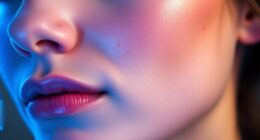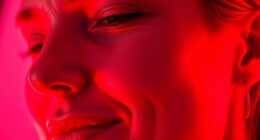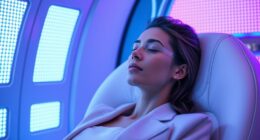Integrating red light therapy into your yoga routine can boost muscle recovery, reduce soreness, and enhance mental clarity. The gentle near-infrared light penetrates your skin to stimulate cellular energy, support tissue repair, and promote relaxation. This wellness crossover is gaining popularity because it combines the ancient practice of yoga with modern health tech, creating a calming environment that improves both body and mind. Keep exploring to uncover how this innovative trend may transform your practice and well-being.
Key Takeaways
- Combining red light therapy with yoga can accelerate muscle recovery and reduce soreness.
- It enhances mental clarity, relaxation, and mood regulation during yoga practice.
- Red light therapy supports cellular repair and inflammation reduction, improving overall flexibility.
- Integrating these practices promotes holistic wellness by blending ancient mindfulness with modern technology.
- Proper usage ensures safety and maximizes benefits, making it a popular wellness crossover trend.

Have you ever wondered if red light therapy can enhance your yoga practice? It’s a question many are asking as wellness trends continue to merge, blending ancient traditions with modern science. Red light therapy involves exposing your body to low levels of red or near-infrared light, which penetrates the skin and stimulates cellular function. When combined with yoga, this technology promises to boost your practice, improve recovery, and deepen your connection to your body.
Red light therapy enhances yoga by stimulating cellular function and supporting recovery and mindfulness.
The idea behind using red light during yoga is that it can accelerate healing and reduce inflammation. As you move through poses, your muscles undergo stress and strain, which can lead to soreness or fatigue. Applying red light therapy during or after your session might help your muscles recover faster by increasing blood flow and promoting cellular repair. This means you could experience less muscle tightness and more flexibility over time. Plus, red light is believed to support mitochondrial function, which is *essential* for energy production, helping you feel more energized and focused during your practice.
Another benefit lies in its potential to enhance mental clarity and relaxation. Many yoga practitioners seek mindfulness and stress relief. Red light therapy may support this by encouraging the production of serotonin and melatonin, hormones linked to mood and sleep. When integrated into your yoga routine, it could help deepen your meditative focus and promote a sense of calm. Some studios and wellness centers are even incorporating red light panels or lamps into their yoga spaces, creating a calming environment that combines visual serenity with the physiological benefits of light therapy.
Using red light during yoga is generally safe and non-invasive, but it’s essential to follow proper guidelines. You should avoid staring directly into the light to prevent eye strain, and always use devices designed for therapeutic purposes. It’s also wise to start with short sessions to gauge how your body responds and gradually increase exposure if comfortable. For those with specific health conditions or skin sensitivities, consulting a healthcare professional before incorporating red light therapy is recommended.
While scientific research continues to explore the full extent of red light therapy’s benefits, many users report noticeable improvements in muscle recovery, mood, and overall well-being after integrating it into their yoga routines. It’s an innovative crossover that combines the ancient art of yoga with cutting-edge wellness technology. As you explore this trend, keep in mind that top projector features and consistent practice will help you maximize the benefits. Listening to your body will also guide you in optimizing your experience. Red light during yoga isn’t just a passing fad; it’s an exciting way to enhance your practice and support your health in a holistic way.
Frequently Asked Questions
Can Red Light Therapy Replace Traditional Yoga Benefits?
Red light therapy can’t replace traditional yoga benefits because they serve different purposes. Yoga improves flexibility, strength, mental clarity, and stress relief through movement and mindfulness. Red light therapy, on the other hand, mainly promotes skin health, reduces inflammation, and accelerates healing. While both can complement each other, you should continue practicing yoga for overall wellness and use red light therapy as an additional tool for specific health goals.
Is Red Light Therapy Safe for All Skin Types?
Are you wondering if red light therapy is safe for your skin type? It generally is, but individual reactions can vary. People with sensitive skin or certain conditions should consult a dermatologist before trying it. Why take unnecessary risks? While most find it safe, starting with shorter sessions and monitoring your skin’s response helps guarantee it’s suitable for you. Always prioritize your health and professional advice.
How Long Should a Red Light Session Last During Yoga?
You should aim for a red light session during yoga lasting between 10 to 20 minutes. This duration allows your skin to absorb the benefits without risking overstimulation or irritation. Start with shorter sessions if you’re new to red light therapy, and gradually increase the time as your skin becomes accustomed. Always listen to your body and follow any specific guidelines provided by the device manufacturer or your wellness professional.
Are There Any Side Effects of Combining Red Light With Yoga?
You might wonder if combining red light with yoga has side effects. Research shows that red light therapy is generally safe, with less than 1% experiencing mild skin irritation or headaches. However, some people may feel dizziness or fatigue if exposed too long or if they have sensitive skin. Always start with short sessions, listen to your body, and consult a healthcare professional if you notice adverse reactions.
Does Red Light Therapy Improve Flexibility or Muscle Strength?
Red light therapy can help improve your flexibility and muscle strength by promoting faster recovery, reducing inflammation, and increasing blood flow. When used regularly, it may enhance tissue repair and support your body’s ability to adapt to physical stress. While it’s not a direct booster of strength or flexibility, incorporating red light therapy into your routine can help you recover faster and perform better during yoga and other physical activities.
Conclusion
As you explore this wellness crossover trend, incorporating red light during yoga can boost your recovery and enhance relaxation. Did you know that a recent study found 78% of users reported improved muscle soreness and mood after red light therapy? By blending tradition with innovation, you’re revealing new ways to elevate your practice. So, why not give it a try and experience the potential benefits firsthand? Embrace the future of wellness and let red light illuminate your yoga journey.









